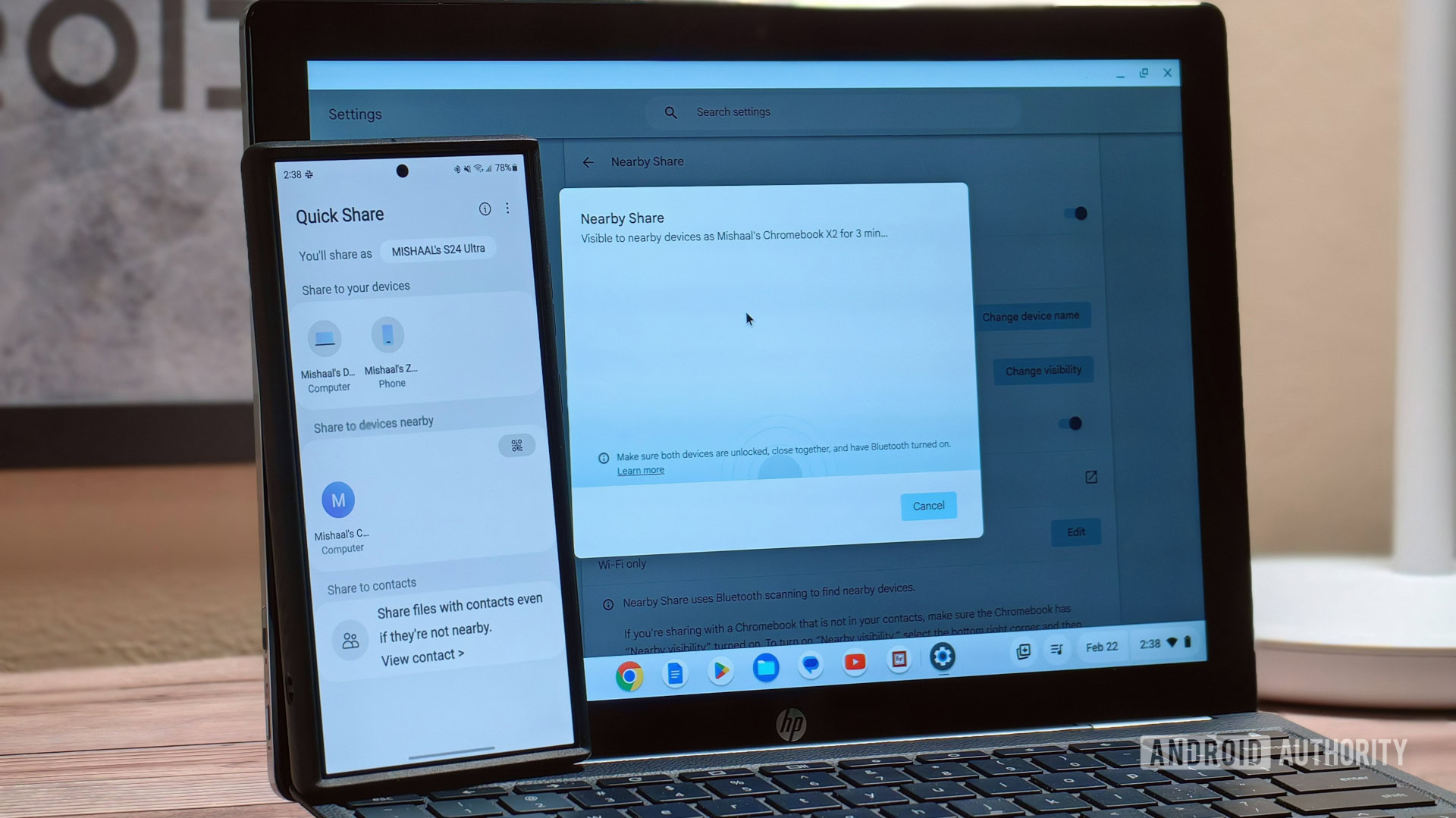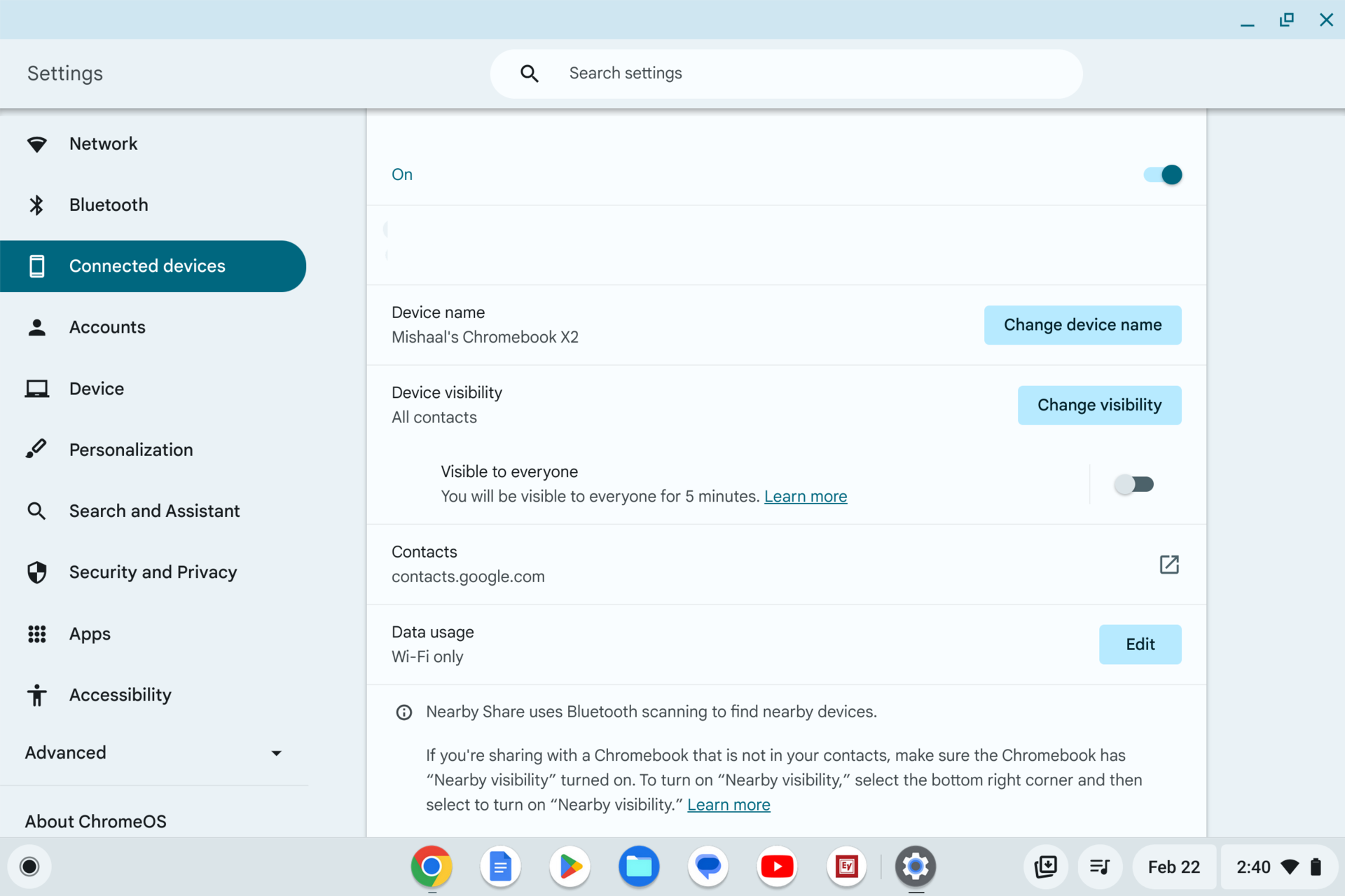
Mishaal Rahman / Android Authority
long story short
- Chrome OS does not currently support peer-to-peer Wi-Fi, but it looks like that will change soon.
- This will make Quick Share (formerly Nearby Share) run faster than it currently does on Chrome OS.
- Android devices already support peer-to-peer Wi-Fi.
Google’s Chrome OS operating system has many neat features to help you integrate your Android phone with your Chromebook. Most of the cross-device functionality falls under the umbrella of Phone Hub, but if you frequently share files between Android devices, there’s an additional feature you’re probably already familiar with: Quick Share.
Quick Share (formerly Nearby Share) lets you share files between Android devices, Chromebooks, and Windows PCs. Just like Android, the feature is built into the Chromebook’s operating system. Unlike most Android devices, though, Chromebooks lack the critical connectivity features to share files at the fastest transfer speeds via Quick Share, but that could soon change.
What is Wi-Fi Direct?

Mishaal Rahman / Android Authority
Quick Share supports file transfer via Bluetooth or Wi-Fi. Bluetooth is used to scan for nearby devices and then connect to them, but is generally not used to actually transfer files. This is because it is much slower than Wi-Fi at transferring data, making it a last resort when a suitable Wi-Fi connection cannot be established.
Establishing a Wi-Fi connection on Android, Chrome OS, and Windows is easy as you just need to connect the sender and receiver devices to the same Wi-Fi network. However, if you’re sharing files between two or more Android devices, you don’t even need to connect them to the same Wi-Fi access point to get the fastest transfer speeds. This is because Quick Share on Android can take advantage of Wi-Fi Direct, ie. Peer-to-peer Wi-Fi.
Wi-Fi Direct provides a point-to-point Wi-Fi experience, resulting in very fast transfer speeds.
Wi-Fi Direct is a standard that allows Wi-Fi-enabled devices to connect directly to each other without the need for an intermediate router or access point. One device (sender) creates a temporary Wi-Fi hotspot to which other devices (receivers) can connect. Unlike the Wi-Fi hotspot functionality built into most Android phones, there’s no need to modify network settings to create or join a Wi-Fi Direct network when you’re just trying to share some files between Android devices. This is because Quick Share leverages Android’s Wi-Fi Direct API to create a network on the sending device, and the receiving device automatically connects to that network.
With Wi-Fi Direct, Android devices don’t need to be connected to the same access point for optimal file transfer speeds, as fast sharing turns the sender device into a portable Wi-Fi hotspot regardless of location. In theory, data transfer speeds over a Wi-Fi Direct connection are faster than data transfer speeds over a traditional Wi-Fi connection because routers or other devices on the same network don’t incur any overhead competing for bandwidth. Other factors, such as the distance to the access point and the specifications of the router’s Wi-Fi chip, may also affect transfer speeds. Plus, it’s not always easy (or cheap) to connect every device to the same wireless network, especially when traveling.
Wi-Fi Direct is coming to Chrome OS soon
Obviously, a point-to-point Wi-Fi connection is the best medium for sharing files via Quick Share, but unfortunately, Chrome OS doesn’t support Wi-Fi Direct. However, this will change in the future, as the Chrome OS team has been working on implementing support for peer-to-peer Wi-Fi over the past few months. A large number of code changes under the “p2p” theme have been merged into Chromium Gerrit, and just a few days ago, code changes to add a feature flag to enable Wi-Fi Direct on Chrome OS were merged.
The description of this feature flag is as follows: Enables the WiFi direct functionalities in ChromeOS. While the flag’s description doesn’t directly name “Quick Share,” the patch’s description says the flag’s purpose is to “enable or disable Wi-Fi Direct media for nearby sharing.”Additionally, a comment in one of the patch files states that enabling this flag “will allow the Nearby Share feature to leverage Wi-Fi P2P to share data.” The reason Nearby Share was removed from the flag description is that Wi-Fi Direct can be used by other apps Program use, e.g. WiDi Streaming Cast (i.e. wireless display streaming).
We don’t know when Wi-Fi Direct support will roll out to existing Chromebooks, but the badge should appear in the Chrome OS preview track soon. As for when Quick Share on Chrome OS will be updated to use Wi-Fi Direct, that’s another thing we’re not sure about. However, given how point-to-point Wi-Fi standards compare to the Wi-Fi chips in modern devices, it’s likely that many existing Chromebooks will support the feature when it becomes available. Hopefully Google will show some of this love to their Windows client Quick Share, which also lacks Wi-Fi Direct support, although Microsoft appears to have provided an API for it.